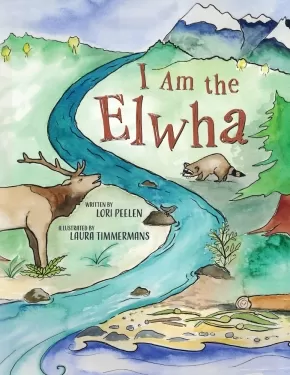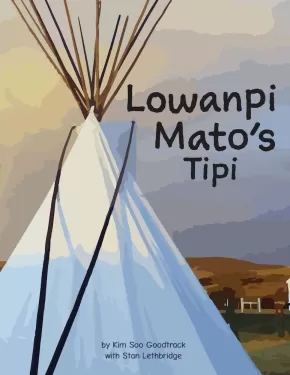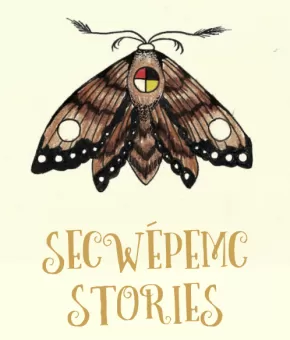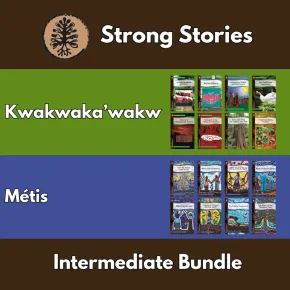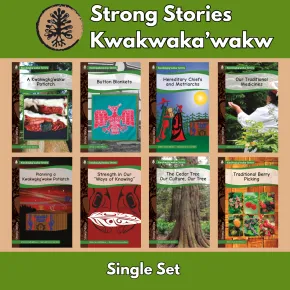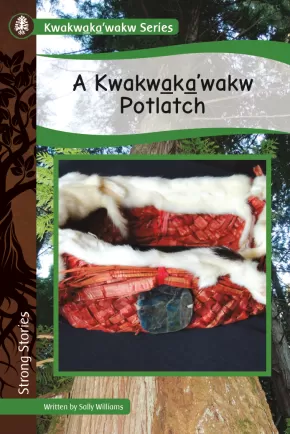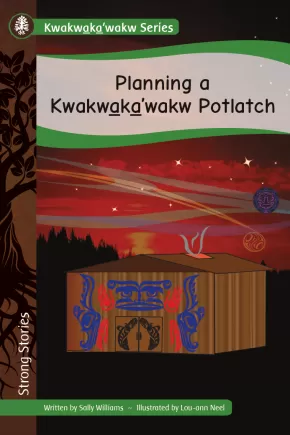
Grade 4
16
-
30
of
87 Results;
Sort By
Go To
of 6
I Am the Elwha (HC)
 $18.50
$18.50

Artists:
Format:
Hardcover
Text Content Territories:
Indigenous American; Native American; Salish; Coast Salish; Klallam (Clallam); Lower Elwha Klallam Tribe;
ISBN / Barcode: 9781771744744
Synopsis:
Synopsis:
“I am the Elwha, rushing down to the sea. I am the Elwha, wild and free.”
The Elwha River flows 72 kilometres (45 miles) from its source in the Olympic Mountains to the Strait of Juan de Fuca in the Pacific Northwest. Uniquely, it hosts all six salmon species (Pink, Chinook, Coho, Sockeye, Steelhead, and Chum) as well as several species of trout.
In 1911 two dams were built on the river. The dams blocked the migration routes of the salmon and dramatically altered the entire river ecosystem for 100 years. In 2012 the dams were decommissioned and the world’s largest dam removal and habitat restoration project began.
In this lyrical and beautifully illustrated book, the author chronicles the history of the Elwha. Narrated by the powerful voices of plants and animals that inhabit the river ecosystem, the dam builder, a worker, and the river itself, this story celebrates the ongoing rewilding of this special environment and offers a welcome to all of the creatures who are coming home.
To learn more visit: www.elwha.org
Awards
- 2021 Riverby Award for Young Readers
Reviews
“I Am the Elwha is a powerful read about a powerful river and those who value and protect it." – Raina Delisle, Hakai Magazine
Educator Information
At the back of the book are three pages of cultural, scientific, and historical information that discuss the following:
- the importance and symbolism of salmon to the Lower Elwha Klallam Tribe and other Coastal Salish Tribes
- facts about the six species of salmon found in the Elwha River (Chinook, Pink, Chum, Sockeye, Coho, and Steelhead)
- the history of the Elwha River and its status today
Keywords / Subjects: The Elwha River, Rivers, Dams, History, Environmental Awareness, Lower Elwha Klallam Tribe, Coast Salish, Native American, Culture, Washington, Animals, Salmon, First Salmon Ceremony, Plants, Nature, Settlers, Social Responsibility, Environmental Activism, Poetry.
Recommended for grades 3 to 7.
Additional Information
32 Pages | 8.5" x 11" | ISBN: 9781771744744 | Hardcover
Authenticity Note: This lyrical story, which chronicles the history of the Elwha River, is written by Lori Peelen. Robert Elofson, Tribal Elder and Harvest Manager in the Natural Resources Department for the Lower Elwha Klallam Tribes, approved Lori's work and contributed a few pages of back matter at the end of the work. Lori's story was further approved by Frances Charles, the Tribal Councilwoman for the Lower Elwha Klallam Tribe, after the entire council read and approved it.
The Canadian Content label has been applied because the illustrator of this work is Canadian.
Lowanpi Mato’s Tipi
 $18.50
$18.50

Artists:
Format:
Hardcover
Text Content Territories:
Indigenous Canadian; First Nations; Sioux; Lakota;
ISBN / Barcode: 9781771744751
Synopsis:
Synopsis:
“Hokahe! Welcome!”
Welcome to Wood Mountain, home of the Lakota People, in southern Saskatchewan. It is here that we meet Stan Lethbridge, whose ancestral name is Lowanpi Mato (Singing Bear).
Join Lowanpi Mato as he prepares to set up his summer Tipi. He shares with us Lakota life values and traditions, and how they connect to building and taking care of a Tipi. He teaches us that to build a Tipi you need many items; some are from natural sources and others are purchased from a store. Lowanpi Mato takes us through a step-by-step building process so that we can all learn how a Tipi is built.
The Lakota language is woven throughout the story. The Lakota counting chart on pages 30 and 31 invites you to learn to count and have some fun looking back through the book to find items that match each number.
Welcome to Wood Mountain, home of the Lakota People, in southern Saskatchewan. It is here that we meet Stan Lethbridge, whose ancestral name is Lowanpi Mato (Singing Bear).
Join Lowanpi Mato as he prepares to set up his summer Tipi. He shares with us Lakota life values and traditions, and how they connect to building and taking care of a Tipi. He teaches us that to build a Tipi you need many items; some are from natural sources and others are purchased from a store. Lowanpi Mato takes us through a step-by-step building process so that we can all learn how a Tipi is built.
The Lakota language is woven throughout the story. The Lakota counting chart on pages 30 and 31 invites you to learn to count and have some fun looking back through the book to find items that match each number.
Educator Information
Lakota language is woven throughout this story, as are the seven values of Lakota life.
Lakota language is woven throughout this story, as are the seven values of Lakota life.
Includes a counting chart from 1 to 20 in Lakota, as well as a search-and-find counting game.
Additional Information
32 pages | 8.5" x 11" | Hardcover | ISBN: 9781771744751
32 pages | 8.5" x 11" | Hardcover | ISBN: 9781771744751
Porcupine (PB)
 $11.95
$11.95

Artists:
Format:
Paperback
Text Content Territories:
Indigenous Canadian; First Nations; Salish; Interior Salish; Secwepemc (Shuswap);
ISBN / Barcode: 9781771745710
Synopsis:
Synopsis:
Kú7pece (Porcupine) has always struggled with his emotions and pushed his relations away. Kú7pece does not like this part of himself and wants to explore his identity and learn more about himself, his family, and the land.
To connect with his relations and his friends, Kú7pece decides to build a gathering place: a c7ístkten̓ (winter home). This is a place he is hoping his relations can gather and learn about each other through sharing stories. However, Kú7pece traps the sun and soon gets distracted by the sun’s heat and light. So much so, he forgets who he is and his purpose. Soon he is trapped too and cannot see that he is neglecting his responsibilities.
It takes the sacrifice of his relations and friends to help him realize he was trapped in his own reality. Once he realizes the lesson of the sacrifice of his friends – that they were trying to help him reconnect to his own place and purpose – he uses all his courage to turn away from the sun’s heat and light. Slowly, he remembers his identity, purpose, and responsibilities. In the end, Kú7pece finds himself again and reconnects with his relations to gather to tell stories, learn from each other, and support one another.
Porcupine is a story about expressing emotions and being considerate to the needs of others. It works well as a bedtime story or read-aloud for classrooms.
This book works well with others by Mike Bowden and Kelsey Jules, including Four Winds, Bear and Coyote, and Chief Goose.
Educator Information
Recommended for grades 3 to 7.
This book is part of the Secwépemc Stories series.
This story is a great resource to introduce Indigenous languages to young readers. Secwepemctsín is one of 30 distinct Indigenous languages in British Columbia and is in the process of being revitalized after governments and religions developed policies to eliminate the rich language and culture of Indigenous peoples. The book integrates Secwépemc words into the text and includes a pronunciation guide on every page.
This story connects to the BC First Peoples’ Principles of Learning: learning is holistic, reflexive, experiential, and relational; learning involves the consequences of one’s actions; learning is embedded in story; and learning involves patience and time. Learning from Indigenous stories can be different and personal every time a story is read or told, depending on context. This book provides an opportunity for those reading to reflect, explore, connect, and learn on a personal interpretative level.
Curriculum links:
- Social emotional learning: identity, self-awareness, emotions, family, community, relationship skills
- Reading and language skills
- Indigenous knowledge and traditions
Additional Information
24 Pages | Colour illustrations | 22 x 28 cm | ISBN: 9781771745710 | Paperback
Secwépemc Stories Bundle
 $48.92 $54.35
$48.92 $54.35

Text Content Territories:
Indigenous Canadian; First Nations; Salish; Interior Salish; Secwepemc (Shuswap);
ISBN / Barcode: 9781771746632
Synopsis:
Synopsis:
This bundle includes all four Secwépemc stories from Mike Bowden:
- Four Winds (hardcover)
- Porcupine (paperback)
- Bear and Coyote (paperback)
- Chief Goose (paperback)
Secwépemc Stories are the collaborative work of Secwépemc author Mike Bowden and Secwépemc artist Kelsey Jules. These stories convey Secwépemc teachings and embody Indigenous ways of knowing. Mike, a storyteller and educator, strongly believes in story as a way of learning and understanding the world and our relationships within it. Secwépemc language is integrated into the stories and accompanied by pronunciation guides.
These stories connect to the BC First Peoples principles of learning and provide opportunities for those reading to reflect, explore, connect and learn on a personal interpretative level.
Additional Information
Books are 8.5" x 11" | 24 Pages | ISBN 9781771746632
Scroll below to learn more about each book included.
A Salmon's Sky View
 $18.50
$18.50

Artists:
Format:
Hardcover
ISBN / Barcode: 9781771744461
Synopsis:
Synopsis:
The ink and watercolour illustrations in this book reflect the life cycle of a salmon from the salmon’s point of view looking up from underwater. Silhouette images provide a clue to the seasons and to the predators the salmon encounters throughout its life. The story reminds us how the salmon demonstrates great determination and strength in its long journey from the stream where life begins, to the ocean, and back to its natal stream.
Carol ends the story with a step-by-step instructional guide to create your own ink and watercolour image.
Educator Information
This is the 10th anniversary edition from CSWA Science in Society award-winning author/illustrator Carol McDougall, B. Ed., M.A. Carol is an international educator and conservationist with decades of classroom and fine arts teaching experience. She conducts workshops on using the arts to help make learning creative and engaging.
Recommended Grades: K-5.
Additional Information
32 pages | 11" x 8.5" | ISBN: 9781771744461 | Hardcover
Four Winds
 $18.50
$18.50

Artists:
Format:
Hardcover
Text Content Territories:
Indigenous Canadian; First Nations; Salish; Interior Salish; Secwepemc (Shuswap);
ISBN / Barcode: 9781771744478
Synopsis:
Synopsis:
A curious Qelmúcw (Person) from the Secwépemc Nation is learning about the world around him with the help of some of his relations. Sk̓elep (Coyote) and Tree guide Qelmúcw in understanding Cmesekst te Snewt (The Four Winds).
Qelmúcw experiences the power of a learning journey using perseverance and courage. He discovers that for meaningful learning to happen he needs to find balance or he could be blown off his learning journey, or even worse, not be completely open to his learning.
This story reflects the reciprocal learning and understanding relationship between a human being and all life and elements (all of relations). It models and reflects the importance of First Peoples’ Principles of Learning: learning is holistic, reflexive, experiential, and relational; learning involves the consequences of one’s actions; learning is embedded in story; and learning involves patience and time. Learning from Indigenous stories can be different and personal every time a story is read or told, depending on context.
Four Winds is the perfect bedtime story or read-aloud in the classroom.
This book works well alongside other books by Mike Bowden and Kelsey Jules, including Chief Goose and Porcupine, and includes a familiar character from Bear and Coyote.
Educator Information
Recommended for grades 3 to 7.
Recommended for grades 3 to 7.
This book is part of the Secwépemc Stories series.
This story is a great resource to introduce Indigenous languages to young readers. Secwepemctsín is one of 30 distinct Indigenous languages in British Columbia and is in the process of being revitalized after governments and religions developed policies to eliminate the rich language and culture of Indigenous peoples. The book integrates Secwépemc words into the text and includes a pronunciation guide on every page. The back of the book includes language resources and a link to an audio pronunciation guide for the Secwépemc alphabet.
This story connects to the BC First Peoples’ Principles of Learning and provides an opportunity for those reading to reflect, explore, connect, and learn on a personal interpretative level.
Curriculum links:
- Social emotional learning: community, helping others, critical thinking, learning from mistakes and trying again
- Reading and language skills
- Indigenous knowledge and traditions
Additional Information
32 Pages | 8.5 " x 11" | ISBN: 9781771744478 | Hardcover
32 Pages | 8.5 " x 11" | ISBN: 9781771744478 | Hardcover
Strong Stories - Intermediate includes Kwakwaka’wakw and Métis - Single Set Bundle
 $143.28 $159.20
$143.28 $159.20

Text Content Territories:
Indigenous Canadian; First Nations; Kwakwaka'wakw (Kwakiutl); Métis;
ISBN / Barcode: 9781771746670
Synopsis:
Synopsis:
This Intermediate bundle features one copy each of two Strong Stories sets: Kwakwaka’wakw and Métis (16 books total).
Kwakwaka’wakw Strong Stories include the following from authors Sally Williams and Bobbie Wildman and illustrator Lou-ann Neel:
A Kwakwaka’wakw Potlatch
Button Blankets
Hereditary Chiefs and Matriarchs
Our Traditional Medicines
Planning a Kwakwaka’wakw Potlatch
Strength in Our “Ways of Knowing”
The Cedar Tree Our Culture, Our Tree
Traditional Berry Picking
Métis Strong Stories include the following from author and illustrator Leah Marie Dorion:
How the Moon Came to Be
Métis and Dandelions
Métis Singing Sticks: A Story About Métis Musical Traditions
Pemmican Berries
Poems to Honour Mother Earth
The Helpful Sasquatch
Métis Transport Boxes
The Story of the Tamarack Tree
Reading levels span from grade 4 to grade 6. Recommended for intermediate students.
Additional Information
ISBN: 9781771746670
Strong Stories Kwakwaka’wakw - Reading Bundle
 $429.84 $477.60
$429.84 $477.60

Text Content Territories:
Indigenous Canadian; First Nations; Kwakwaka'wakw (Kwakiutl);
ISBN / Barcode: 9781771746694
Synopsis:
Synopsis:
Bundle includes all 8 titles, 6 of each, in the Strong Stories Kwakwaka’wakw series (48 books total).
Recommended for intermediate students.
Books in the Kwakwaka’wakw series include the following from authors Sally Williams and Bobbie Wildman and illustrator Lou-ann Neel:
A Kwakwaka’wakw Potlatch
Button Blankets
Hereditary Chiefs and Matriarchs
Our Traditional Medicines
Planning a Kwakwaka’wakw Potlatch
Strength in Our “Ways of Knowing”
The Cedar Tree Our Culture, Our Tree
Traditional Berry Picking
Additional Information
ISBN: 9781771746694
Strong Stories Kwakwaka’wakw - Single Set Bundle
 $71.64 $79.60
$71.64 $79.60

Text Content Territories:
Indigenous Canadian; First Nations; Kwakwaka'wakw (Kwakiutl);
ISBN / Barcode: 9781771745840
Synopsis:
Synopsis:
Own the entire set of Kwakwaka’wakw Strong Stories! (8 books total)
Recommended for intermediate students.
Books in the Kwakwaka’wakw series include the following from authors Sally Williams and Bobbie Wildman and illustrator Lou-ann Neel:
A Kwakwaka’wakw Potlatch
Button Blankets
Hereditary Chiefs and Matriarchs
Our Traditional Medicines
Planning a Kwakwaka’wakw Potlatch
Strength in Our “Ways of Knowing”
The Cedar Tree Our Culture, Our Tree
Traditional Berry Picking
Additional Information
ISBN: 9781771745840
Strong Stories Kwakwaka’wakw: A Kwakwaka’wakw Potlatch
 $9.95
$9.95

Format:
Paperback
Text Content Territories:
Indigenous Canadian; First Nations; Kwakwaka'wakw (Kwakiutl);
ISBN / Barcode: 9781771743068
Synopsis:
Synopsis:
Kwakwaka’wakw (kwok-wok-ya-wokw) people have many sacred ceremonies to protect, nurture, and uplift their spirits. A Potlatch is a time for ceremony and community. What kinds of community gatherings and ceremonies do you participate in?
Educator & Series Information
Recommended for intermediate students (grades 4-6).
A Kwakwaka’wakw Potlatch is part of the Strong Stories: Kwakwaka’wakw series. Strong Stories focus on different First Nation territories from across Canada and the United States. These stories reflect the belief that our stories are the roots of our people, our lands and our cultures. It is from our stories that we grow and become strong and proud.
Additional Information
16 pages | 6.00" x 9.00" | ISBN: 9781771743068
Strong Stories Kwakwaka’wakw: Button Blankets
 $9.95
$9.95

Format:
Paperback
Text Content Territories:
Indigenous Canadian; First Nations; Kwakwaka'wakw (Kwakiutl);
ISBN / Barcode: 9781771743075
Synopsis:
Synopsis:
One type of regalia that is worn by the Kwakwaka’wakw (kwok-wok-ya-wokw) is the button blanket. The blanket is often worn by women during a potlatch or other sacred ceremonies. Have you ever worn any regalia at a special ceremony?
Educator & Series Information
Recommended for intermediate students (grades 4-6).
Button Blankets is part of the Strong Stories: Kwakwaka’wakw series. Strong Stories focus on different First Nation territories from across Canada and the United States. These stories reflect the belief that our stories are the roots of our people, our lands and our cultures. It is from our stories that we grow and become strong and proud.
Additional Information
16 pages | 6.00" x 9.00" | ISBN: 9781771743075
Strong Stories Kwakwaka’wakw: Hereditary Chiefs and Matriarchs
 $9.95
$9.95

Artists:
Format:
Paperback
Text Content Territories:
Indigenous Canadian; First Nations; Kwakwaka'wakw (Kwakiutl);
ISBN / Barcode: 9781771743082
Synopsis:
Synopsis:
Hereditary chiefs and matriarchs are important people within the Kwakwaka’wakw (kwok-wok-ya-wokw) culture. They are both powerful and respected positions held within the community. Are there some important people within your community?
Educator & Series Information
Recommended for intermediate students (grades 4-6).
Hereditary Chiefs and Matriarchs is part of the Strong Stories: Kwakwaka’wakw series. Strong Stories focus on different First Nation territories from across Canada and the United States. These stories reflect the belief that our stories are the roots of our people, our lands and our cultures. It is from our stories that we grow and become strong and proud.
Additional Information
16 pages | 6.00" x 9.00" | ISBN: 9781771743082
Strong Stories Kwakwaka’wakw: Our Traditional Medicines
 $9.95
$9.95

Format:
Paperback
Text Content Territories:
Indigenous Canadian; First Nations; Kwakwaka'wakw (Kwakiutl);
ISBN / Barcode: 9781771743099
Synopsis:
Synopsis:
Kwakwaka’wakw (kwok-wok-ya-wokw) people believe that our human spirit must be taken care of. We have medicines for taking care of our body, mind, emotions, and spirit. What do you do to take care of yourself?
Educator & Series Information
Recommended for intermediate students (grades 4-6).
Our Traditional Medicines is part of the Strong Stories: Kwakwaka’wakw series. Strong Stories focus on different First Nation territories from across Canada and the United States. These stories reflect the belief that our stories are the roots of our people, our lands and our cultures. It is from our stories that we grow and become strong and proud.
Additional Information
16 pages | 6.00" x 9.00" | ISBN: 9781771743099
Strong Stories Kwakwaka’wakw: Planning a Kwakwaka’wakw Potlatch
 $9.95
$9.95

Artists:
Format:
Paperback
Text Content Territories:
Indigenous Canadian; First Nations; Kwakwaka'wakw (Kwakiutl);
ISBN / Barcode: 9781771743105
Synopsis:
Synopsis:
Kwakwaka’wakw (kwok-wok-ya-wokw) potlatch ceremonies are sacred. There are many ceremonies that help us to stay connected with our identity and culture. What do you do in your community to stay connected to your culture?
Educator & Series Information
Recommended for intermediate students (grades 4-6).
Planning a Kwakwaka’wakw Potlatch is part of the Strong Stories: Kwakwaka’wakw series. Strong Stories focus on different First Nation territories from across Canada and the United States. These stories reflect the belief that our stories are the roots of our people, our lands and our cultures. It is from our stories that we grow and become strong and proud.
Additional Information
16 pages | 6.00" x 9.00" | ISBN: 9781771743105
Strong Stories Kwakwaka’wakw: Strength in Our “Ways of Knowing”
 $9.95
$9.95

Artists:
Format:
Paperback
Text Content Territories:
Indigenous Canadian; First Nations; Kwakwaka'wakw (Kwakiutl);
ISBN / Barcode: 9781771743112
Synopsis:
Synopsis:
The teachings–ways of knowing–of our Kwakwaka’wakw (kwok-wok-ya-wokw) noble ancestors are ancient beliefs and values. We become stronger as we learn and practise our culture. What is one thing that you practise that makes you a stronger person?
Educator & Series Information
Recommended for intermediate students (grades 4-6).
Strength in Our “Ways of Knowing” is part of the Strong Stories: Kwakwaka’wakw series. Strong Stories focus on different First Nation territories from across Canada and the United States. These stories reflect the belief that our stories are the roots of our people, our lands and our cultures. It is from our stories that we grow and become strong and proud.
Additional Information
16 pages | 6.00" x 9.00" | ISBN: 9781771743112
Sort By
Go To
of 6

